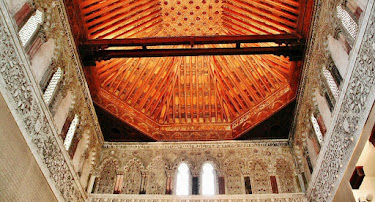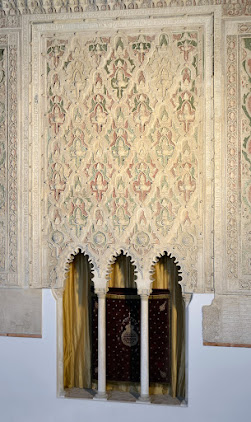Saturday, October 15, 2022
Synagogue of Ha-Levi, Toledo
Samuel ben Meir Ha-Levi Abulafia (c. 1320-1360) was a scion of one of Iberia's most prominent Jewish families. He eventually ended up serving King Pedro the Cruel of Castile, first as chamberlain, then as treasurer and judge. In Castile at that time Jews were tolerated but legally restricted; one of the rules was that their synagogues had to be low and unimpressive. But Pedro valued Ha-Levi's service so greatly that he allowed his treasurer to build a synagogue taller and fancier then the letter of the law permitted. The synagogue was attached to Ha-Levi's house. You can see that the outside was rather nondescript; the bell tower was added later, after it became a church. It was built in 1357-1359.The interior shows some of the wonder of El Andalus, the syncretic beauty born from the fusion of cultures and religions. The builting was designed by master mason Don Meir Abdeil.The balcony was for the women, who were of course separated from the men during worship.The ark.In 1492 Spain's Jews were expelled or forcibly converted to Christianity. Many synagogues became churches, including this one. It was eventually known as Santa Maria del Tránsito, Saint Mary of the Assumption. During the Naploleonic wars it was used as a barracks, and I suppose it was never reconsecrated as a church, since in the later 1800s it became a museum of Sephardic Jewish culture. Somehow it ended up known, for example on wikipedia, under a bizarre fusion of its Jewish and Christian names: the Synagogue del Tránsito.I discovered this little wonder in a book of synagogues I got out of the library. Leafing through this book I was struck that I could tell the region and approximate date of almost all of them because they looked so much like the Chirstian or Muslim buildings of their time. The divisions between the faiths were real and important, but much was shared across them.
Subscribe to:
Post Comments (Atom)









No comments:
Post a Comment